The influence on fish and seafood consumption, and the attitudes and reasons for its consumption in the Croatian population
- 1Department of Health Ecology, Teaching Institute of Public Health of Primorsko-Goranska County, Rijeka, Croatia
- 2Department of Health Ecology, Faculty of Medicine, University of Rijeka, Rijeka, Croatia
Fish makes an important part of the Mediterranean diet, which has been scientifically proven to help preserve human health by protecting against major chronic and inflammatory diseases. Eating fish and seafood is very important, not only for its proven health benefits but also for its positive impact on the environment. Due to many fish and seafood significant positive effects on human health, this study aimed to investigate the socio-demographic factors associated with the consumption of fish and seafood in the population of Primorsko-goranska County in Croatia. Another aim was to determine people's attitudes, choices, and reasons for the consumption of fish and seafood. Self-reported data from 2,910 participants were used. According to the European dietary recommendations for fish consumption, the participants were divided into two groups; the very low to low fish consumption group and the moderate to high fish consumption group, in order to examine the differences in socio-demographic and lifestyle variables, and their attitudes, opinions, and reasons for fish and seafood consumption. More fish and seafood were consumed by women, the elderly, the more educated, non-smokers, and more physically active participants. Age, the highest level of education, and a diet even moderately adherent to the Mediterranean diet was found to significantly increase the likelihood of recommended fish consumption. Participants considered the best reasons to consume more fish lower prices, buy much more locally produced fishery products, and prefer to eat wild-caught fish rather than farmed fish. The study has found a slight increase in fish consumption, although still lower than the European average. It also showed significant socio-demographic associations, also the reasons and attitudes toward higher fish and seafood consumption of the Croatian population. The obtained research data are valuable for planning future public health programs in Croatia aimed at greater consumption of fish and seafood, as well as their promotion as an important part of a sustainable diet.
Introduction
Fish and seafood are foods of high nutritional value, rich in essential amino acids, high-quality proteins, many vitamins (A, B, and D) and minerals (iron, calcium, zinc, selenium), and especially omega-3 polyunsaturated fatty acids (Cardoso et al., 2013; Nesheim et al., 2015; Chen et al., 2022). Strong scientific evidence is confirming the beneficial effects of fish consumption on human health, including cognitive development, mental health, immune system, prevention of anemia, cardiovascular disease, and dementia (Béné et al., 2015; Golden et al., 2016). Fish consumption is an important part of the Mediterranean diet (MD), which has been scientifically proven to help preserve human health by protecting against major chronic and inflammatory diseases (Mazzocchi et al., 2019). In addition, there is a strong evidence suggesting a protective effect of the MD mostly on the risk of cardiovascular disease and certain types of cancer (Mazzocchi et al., 2019; Serra-Majem et al., 2019). The Mediterranean diet is not only considered as “the role model” of a healthy diet but also as a sustainable diet (Burlingame and Dernini, 2012; Portugal-Nunes et al., 2021) providing economic and socio-cultural benefits (Berry, 2019). However, regarding fish quality which is consumed as a part of the diet, its environmental effects can vary greatly between caught and farmed fish since the nutrient content depends on the fish's diet. The recommended weekly fish intake is often not reached due to insufficient supply (Berry, 2019).
Although the beneficial effects of MD on health are well known, the diet of many Mediterranean countries' residents is moving away from traditional MD. At the same time, those countries record a rise in overweight people, obesity, and chronic non-communicable diseases (FAO, 2015; Vilarnau et al., 2019).
As part of a healthy diet, it is usually recommended to consume at least two servings of different types of fish (~240 g) each week, including one serving of oily fish. This consumption provides an average intake of 250 mg EPA + DHA, especially when fish replaces the consumption of less healthy foods (McGuire, 2016; Piepoli et al., 2016). The consumption of fish and seafood varies in all European countries, although according to the Food and Agriculture Organization (FAO), consumption of fish and seafood has increased over the last 60 years (FAO, 2020). A trend toward increasing consumption of fish and seafood can also be observed in Croatia. In 2000, per capita consumption was 7.26 kg and in 2013 it was 19.06 kg, which is an increase of 162.5% (EUMOFA, 2019). The average consumption of fish and seafood in 2017 in the European Union was 24.35 kg per capita, whereas, in Croatia, the consumption in 2017 was 18.7 kg per capita (EUMOFA, 2019). Although the consumption increased by 6% (19.19 kg on average) in 2018, it still remained below the European average consumption (EUMOFA, 2020).
Various factors, such as place of residence (coast or continent), socio-demographic factors, tradition, habits, age, gender, etc. have been shown to influence seafood consumption (Almeida et al., 2015; Murray et al., 2017; Govzman et al., 2021). Moreover, fish and seafood consumption is also influenced by modern lifestyles, urbanization, and consumer preferences (Crona et al., 2020) likewise consumer attitudes toward food and nutrition all have been shown to be important factors influencing seafood consumption (Hearty et al., 2007).
Some of the main factors of insufficient consumption of fish and seafood include price or preferences, but it is worth mentioning that consumer habits and lifestyle can be influenced in the long term (Ministarstvo poljoprivrede, Uprava ribarstva, oŽujak, 2021). Public health activities should be undertaken to influence changes in consumers eating habits toward increasing the consumption of fish and seafood. This paper aims to study the socio-demographic factors related to the consumption of fish and seafood among the population of the Primorsko-goranska County in Croatia. Another aim is to determine people's attitudes, choices, and reasons for the consumption of fish and seafood.
Materials and methods
Participants
This is a quantitative cross-sectional study conducted in the population of Primorsko-Goranska County, Croatia. The study has been carried out under the project “Population exposure to traditional and emerging contaminants due to the consumption of seafood and the characterization of health risks”. The study was conducted in the period from October 2019 to February 2020 and approved by the Ethical Committee of the Teaching Institute of Public Health of Primorsko-Goranska County. Based on a number of residents of Primorsko-goranska county (N = 296,195) (Health Statistical Yearbook of Primorsko-Goranska County for 2020, 2022) a total of 7,745 questionnaires were sent to the residents older than 18 years of Primorsko-goranska County, out of which 5,542 (71.6%) have been returned. For the purposes of this study, only those questionnaires that were completed were further analyzed. Therefore, this study included questionnaires of 2,910 participants (37.6%).
The questionnaire
The questionnaire was anonymous and consisted of three sections. The first section included data on fish and seafood consumption (type of fish and seafood consumed), general habits, preferences and frequency of buying fish, locations and reasons of buying, reasons for consumption, attitudes, and opinions about fish preferences based on its origin (i.e., marine and farmed), and about sources of information on the positive health effects of fish consumption. Participants graded the statements about farmed fish using the Likert scale with five ratings ranging from “strongly disagree” (1) to “strongly agree” (5). The second part was related to sociodemographic characteristics and lifestyle of the study participants and included data on age, gender, geographical region, education level, income, occupation, body weight and height, physical activity, and smoking habits. The third part of the questionnaire evaluated dietary habits. Participants noted their habitual fish intake in offered intervals from once per month or less than to every day, separately for eating at home and for eating in restaurants and/or at work. They also noted their average fish consumption portion in kilograms per household member (estimate based on the mean value of portion consumption and number of household members). Since the Primorsko-goranska County resides by the Mediterranean Sea where the traditional Mediterranean diet is a hereditary diet, the adherence to the MD was assessed with the 14-Item Mediterranean Diet Assessment Tool (Martínez-González et al., 2012). The adherence to MD has categorized into three levels; ≤5 points which meant low adherence, from 6 to 9 points which meant moderate adherence and ≥10 points which meant high adherence to MD. To explore differences in attitudes, opinions, and reasons toward fish and seafood consumption regarding habits of fish consumption, the participants were divided into two groups: the very low to low fish intake group (VLFI; i.e., <1 serving/month to 1 serving/week) and to moderate to high fish intake group (MHFI; i.e., 2–5 servings/week), based on the European dietary recommendations for fish consumption (Lofstedt et al., 2021), where one serving of fish is 130 g.
Statistical analysis
To describe habits of fish and seafood consumption among sociodemographic subgroups of participants, the proportion and means of fish and seafood consumption were calculated and tested for differences with one-way ANOVA test for continuous variables, or with the Chi-Square test for sociodemographic subgroups. The Chi-square test was used for differences between subgroups of participants based on their habitual fish consumption regarding recommended fish intake (Lofstedt et al., 2021) for their attitudes, choices and reasons for consuming fish and seafood and farmed fish. The quantification of the influence of the individual factors is expressed by the odds ratio calculated with the logistic regression method. All tests were performed using Statistica 12.7 for Windows (Statsoft Inc., Tulsa, OK, USA). Results with a P-value of <0.05 were considered statistically significant.
Results
Socio-demographic characteristic and consumption of fish and seafood
The study consisted of 2,910 residents of the Primorsko-goranska County older than 18 years of which over four-fifths (85.3%) were females (p < 0.001; Table 1). Their average age was 38.00 ± 7.14 years, and the most of participants were in the 31–40 years age group (59.0%, p < 0.001). There were statistically more participants with higher education (p < 0.001), employed (p < 0.001), with two average Croatian salaries (p < 0.001), moderately physically active (p < 0.001), non-smokers (p < 0.001), with normal weight (p < 0.001) and diet that moderately adhered to the Mediterranean diet (p < 0.001). On average, participants' fish and fisheries product consumption per week was 412.28 ± 365.01 g (data not shown). Mostly consumed was fresh fish (72.3%), followed by frozen fisheries products (19.0%) and canned fish products (7.8%) (Figure 1). When choosing their most consumed types of fish and fisheries products, participants consumed mainly white fish (56.5%), followed by cephalopods (52.3%), fatty fish (43.9%), and crabs (27.1%) (Figure 2). In Table 1 there are presented the participants' mean fish intake according to their characteristics. Participants in the 51+ age group ate statistically significantly more fish than other age groups (p < 0.001). Participants with higher education (p = 0.013), those who were highly physically active (p = 0.049), smokers (p = 0.025) and those with high adherence to MD (p < 0.001) ate statistically more fish than their related groups. Average weekly consumption of fish didn't significantly differ according to employment, income, and nutrition status (Table 1).
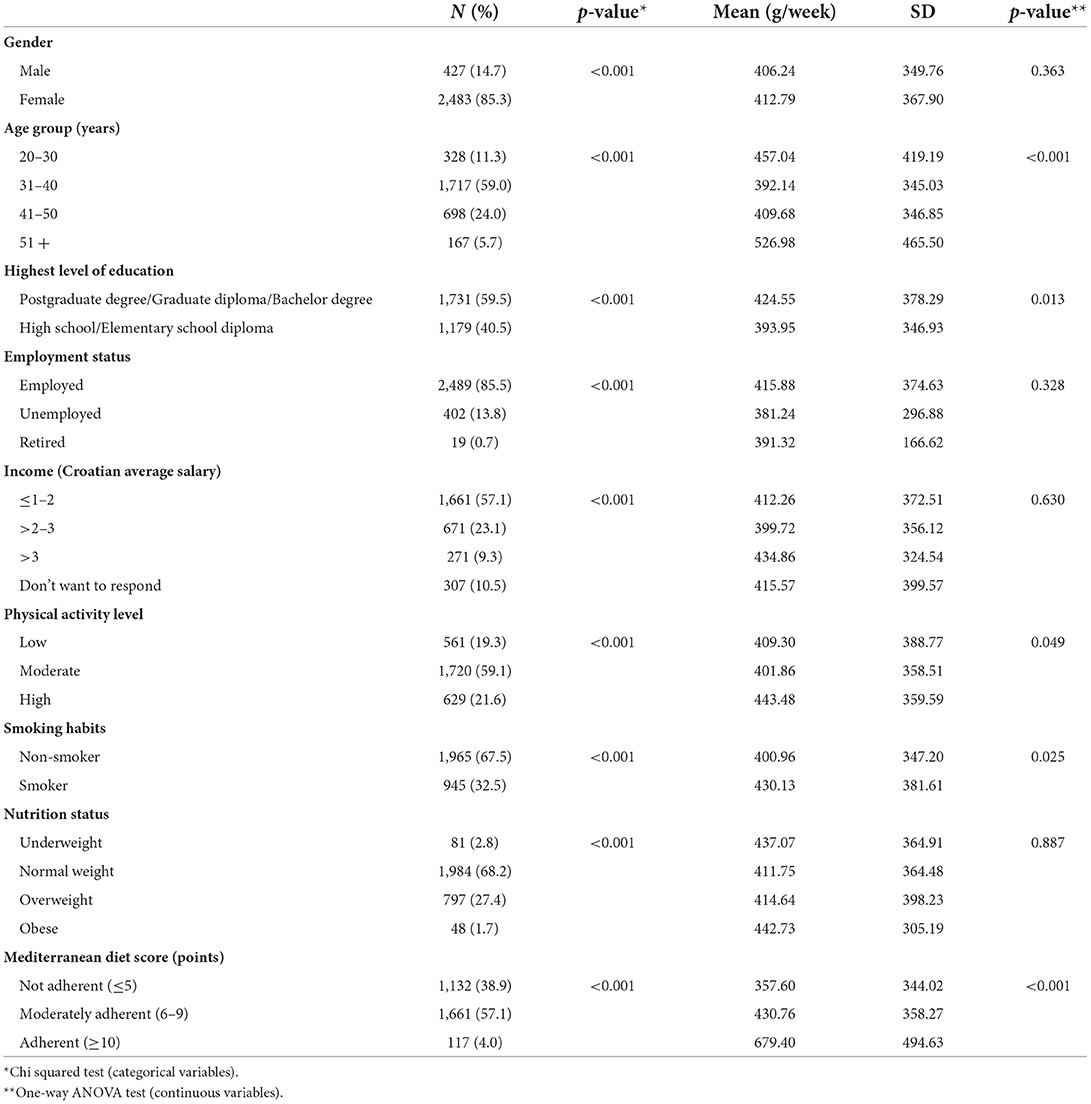
Table 1. Socio-demographic characteristics and mean consumption of fish and fishery products among Croatian adults from Primorsko-goranska County (N = 2,910).
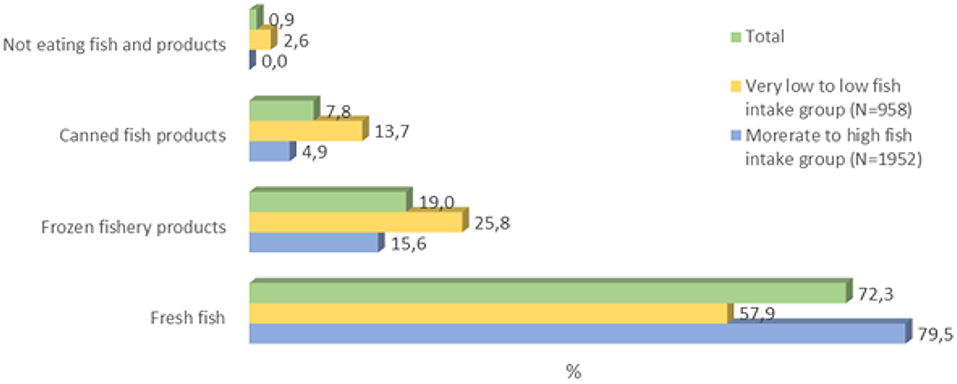
Figure 1. The proportion of fishery products consumption among groups regarding recommended fish intake (N = 2,910).
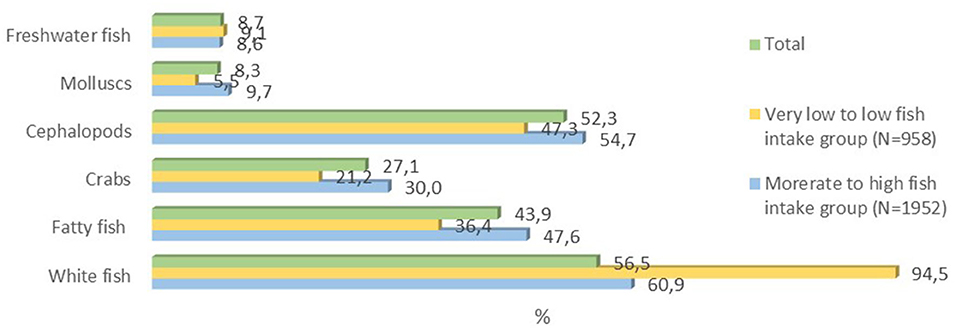
Figure 2. Fishery products frequency consumption among groups regarding recommended fish intake (N = 2,910).
Based on European dietary recommendations for fish consumption (Lofstedt et al., 2021), the moderate to high fish consumption group (MHFI) consumed statistically 2.5 more fish per week (511.12 ± 410.77 g) than the very low to low fish consumption group (VLFI) group (206.05 ± 172.95 g, p <0.001) (data not shown). The MHFI group consumed statistically significantly more fresh fish than the VLFI group (79.5 vs. 57.9%, p < 0.001). The VLFI group had significantly higher consumption of frozen fisheries products (28.8 vs. 15.6%, p < 0.013) and canned fish (13.7 vs. 4.9%, p < 0.020) than the MHFI group (Figure 1).
Regarding the fish and fishery products, the MHFI group consumed significantly more fatty fish (47.6%), crabs (30.0%), cephalopods (54.7%), and molluscs (9.7%) than the VLFI group (36.4, 21.2, 47.3, and 5.5%, p < 0.001). The VLFI group consumed significantly more white fish and freshwater fish than MHFI group (62.4 vs. 60.9%, p < 0.001; 9.1 vs. 8.6%, p < 0.001) (Figure 2).
Socio-demographic and lifestyle factors influencing consumption of fish and seafood
The socio-demographic and lifestyle factors influencing recommended fish and fishery product consumption were assessed by logistic regression (Table 2). It was shown that age was an important influencing factor, the probability of recommended fish intake significantly increases by 1.38 times in older than 40 years, or about 40% (p = 0.001), while among younger people that probability reduces by 18% (p = 0.035) to 35% (p = 0.001). The highest education level significantly increases that probability by 1.72 times, or about 70% (p = 0.001) while the lower one reduces the probability by 19% (p = 0.033).
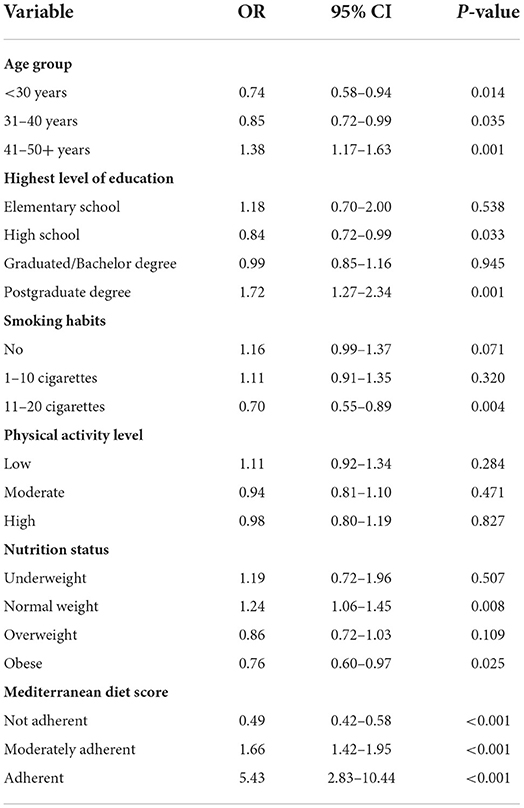
Table 2. The association of participants' socio-demographic characteristics and lifestyle habits with recommended fish intake.
Non-smoking and smoking a smaller number of cigarettes had no statistically significant effect while smoking a larger number of cigarettes reduces the probability by 1.43 times (p = 0.004). Also, having a normal weight significantly increases the probability by 1.24 times (p = 0.008) while having obesity significantly reduces that chance by 1.32 times (p = 0.025). So, if the person smokes more or has obesity, the likelihood to consume fish as recommended decreases by about 30–40%.
On the other hand, a diet even moderate adherent to the Mediterranean diet compared to a diet that is not adherent to MD significantly increases the probability of recommended fish intake by 1.66 times, or about 70% (p < 0.001) while a diet that is completely adherent MD increases that probability five times (p < 0.001).
The participants also reported the most important information available on fishery products (Figure 3). Expiration dates were the most important information about fishery products for participants in both groups, slightly more important for the VLFI group (44.5% MHFI and 48.4% VLFI, respectively, p = 0.046) as well as fishing area or country of origin (21.6% MHFI and 19.3% VLFI, respectively, p = 0.150). Whether fishery products were previously frozen was significantly more important for the MHFI group than for the VLFI group (13.5 and 10.4%, respectively, p = 0.016).
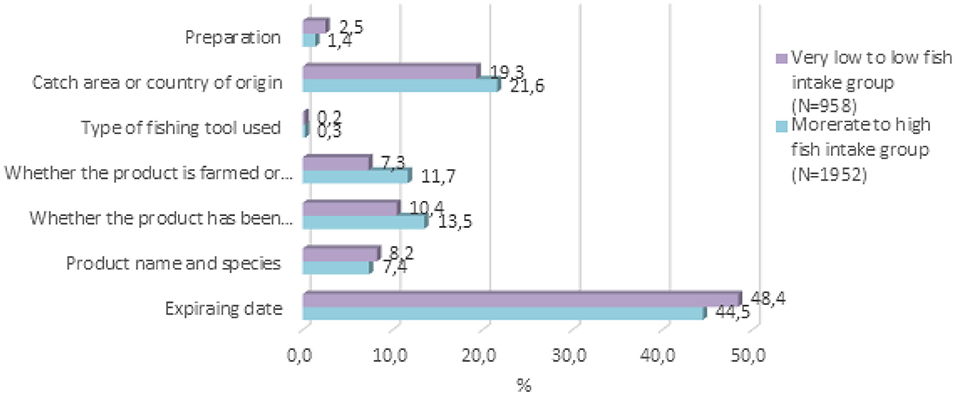
Figure 3. The most relevant information on fishery products among groups regarding recommended fish intake.
Attitudes, choices, and reasons for the consumption of fish and seafood
In Table 3 are presented reasons for encouraging to consume more fish and fishery products according to recommended fish intake group. In both groups, participants considered that the best reasons for promoting the higher fish consumption were lower prices (56.8 and 56.2%, respectively, p = 0.758) and better availability in stores (47.2 and 44.2%, respectively, p = 0.117). With a significant difference, participants in the MHFI group placed more importance on highlighted labels of quality or origin (31.1 and 25.3%, respectively, p = 0.001), while participants in the VLFI group provided more the information about fish preparation recipes (14.5 and 9.2%, respectively, p < 0.001). Other reasons weren't statistically different according to recommended fish intake.

Table 3. Reasons for encouraging to consume more fish and fishery products among groups regarding the recommended fish intake (N = 2,910).
When choosing their main reasons for consumption of fish and fishery products, participants in the MHFI group chosen as the most important reasons the taste (69.5 vs. 58.4%, p < 0.001), health consideration (84.6 vs. 72.3%, p < 0.001), availability (9.7 vs. 5.3%, p < 0.001), good quality (15.1 vs. 5.1, p < 0.001) and a habit to eat (42.4 vs. 18.8%, p < 0.001) significantly more than participants in the VLFI group (Figure 4). Participants were asked to declare from which information sources they learn about the importance of consuming fishery products. All declared that they the most got the information from their friends, relatives and families, significantly more the MHFI group (60.2% of the MHFI and 51.3% of the VLFI, p < 0.001), while the VLFI group significantly more stated to get it online (47.8 MHFI and 51.3 VLFI, p = 0.080). Only a fifth of participants (22.7% of MHFI and 19.5% of VLFI, p = 0.051) declared that information has been provided by health workers, including physicians, nutritionists, etc. (Figure 5).
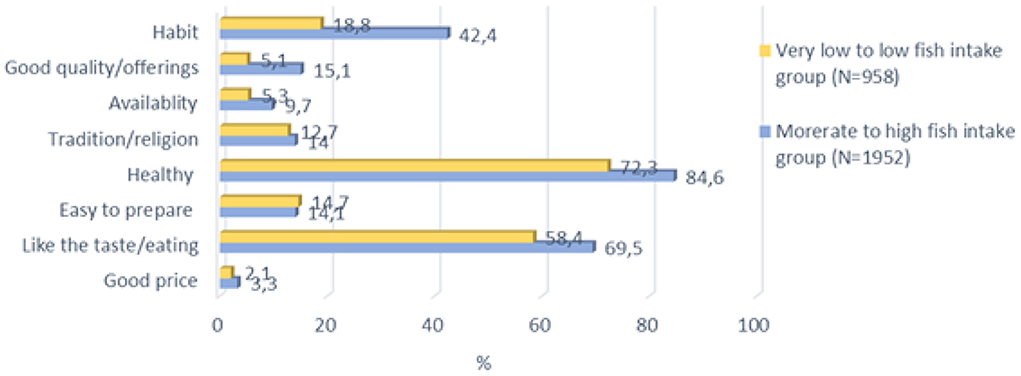
Figure 4. Reasons to consume fish and fishery products among groups regarding the recommended fish intake.
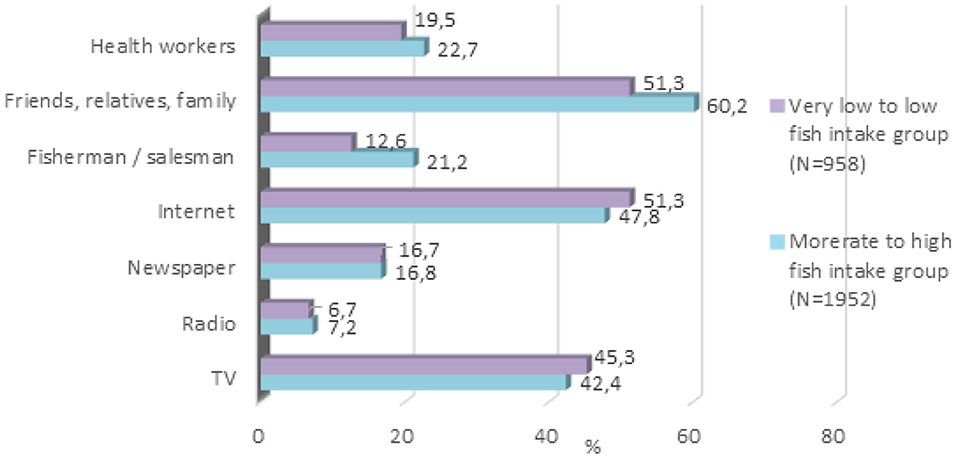
Figure 5. All information channels for knowing the importance of consuming fishery products among groups regarding recommended fish intake.
Regarding the choices and reasons for purchasing fishery products by its origin, the MHFI group was statistically significantly more likely to purchase fishery products from Croatia, i.e., locally (49.1, 39.7%, respectively, p < 0.001) or from all Croatia regions (40.1, 36.0%, respectively, p = 0.035) when compared to the VLFI group. Significantly 2.5 times more the VLFI group said that the origin doesn't matter to them and/or didn't know the origin than the MHFI group (p < 0.001; Table 3). More precisely, the main reasons of buying the fishery product by its origin for both studied groups were first of all better quality and taste (58.7 and 42.3%, respectively, p < 0.001), then availability (41.1 and 39.5%, respectively, p = 0.400), habit (29.3 and 26.0%, respectively, p < 0.062), and support to local fishermen, farmers and for job preservation reasons (28.3 and 19.4%, respectively, p < 0.001) (Table 4).
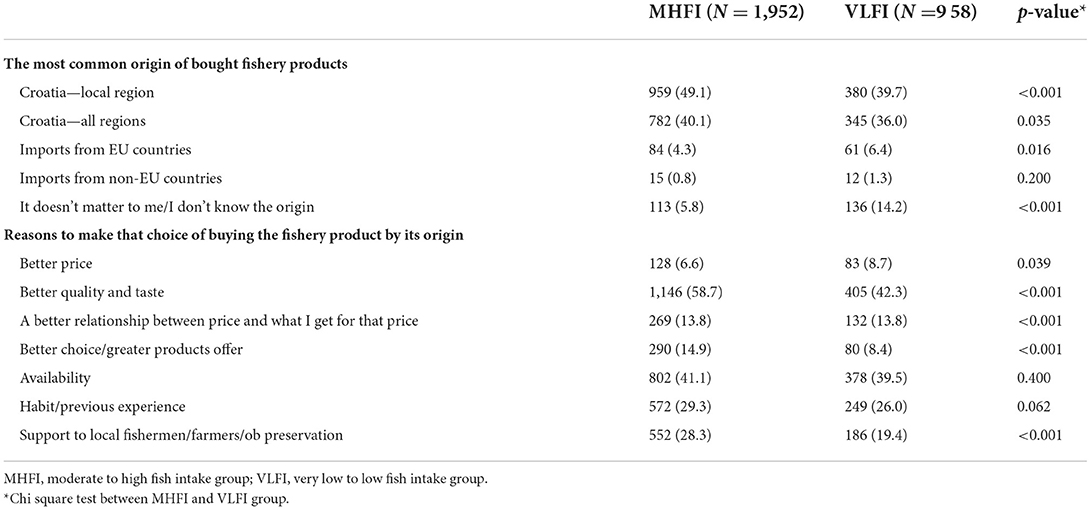
Table 4. Choices and reasons to buy fishery products by its origin (N = 2,910) among groups regarding the recommended fish intake.
Regarding the wild caught or farmed fish consumption preference, both studied groups of participants preferred more eating a wild caught fish over a farmed fish, significantly more the MHFI group than the VLFI group (68.4 and 51.6%, respectively, p < 0.001) (data not shown).
Table 5 shows the respondents' attitudes toward farmed fish and its quality. The MHFI group mostly agreed that farmed fish are fatter than wild fish and of a poorer quality (p < 0.001), while the VLFI group was mostly uncertain about that (p < 0.001; p < 0.001). Both groups mostly were uncertain about that the farmed fish is too expensive (p < 0.001). The MHFI group the group was undivided about the knowledge about farmed fish, in almost equal shares the participants agreed that they know and that they do not know and that they agree and disagree, while the VLFI group significant mostly agreed that they don't know enough about farmed fish (p < 0.001).
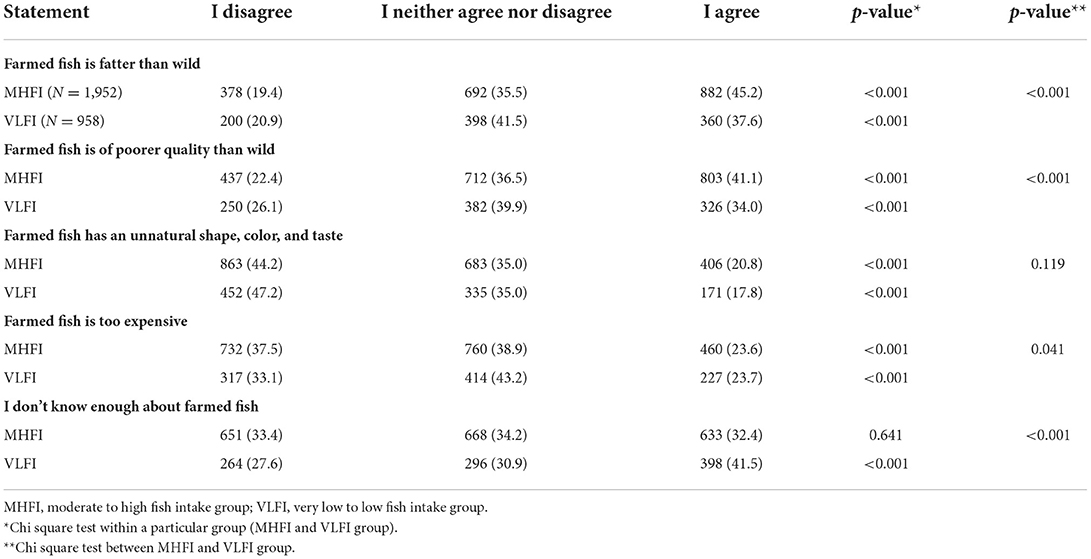
Table 5. Attitudes toward farmed fish and its quality (N = 2,910) among groups according to recommended fish intake.
Discussion
This study is one of the very few conducted in Croatia that investigated factors influencing fish and seafood consumption and examined the reasons for their consumption. Regarding available similar studies (Tomić et al., 2016; Thong and Solgaard, 2017; Sacchettini et al., 2021), this study also assessed the average fish intake regarding socio-demographic characteristics of participants, and the proportion of particular seafood in the coastal part of Croatia regarding recommended fish intake (Lofstedt et al., 2021).
Fish and seafood consumption of croatian participants
Although there's a trend of increasing consumption of fish and seafood in Croatia (EUMOFA, 2019), it has remained below the European average consumption (EUMOFA, 2020), and this study confirmed that. On average, study participants consumed fish and aquatic products 13% less than the EU weekly average and 12% more than the Croatian (EUMOFA, 2020). Those participants who consumed fish two to five servings per week consumed 28% more than the Croatian average consumption, while those who consumed fish less than one serving per month to one serving per week consumed slightly more than half of the Croatian average consumption (EUMOFA, 2020). Of all aquatic food, participants mostly consumed fresh fish, preferably white over fatty fish. These results are consistent with consumption in Portugal and Spain, which also reported the highest consumption of fresh fish, followed by frozen and canned fish (Cardoso et al., 2010, 2013; MARM, 2010). Interestingly, cephalopods have been consumed more than fatty fish which is consistent with the results from Norway (Trondsen et al., 2003), and opposite to Portugal, where more fatty fish was consumed (Cardoso et al., 2013). In Norway salmon, as the most common fatty fish, is traditionally an expensive food, so, understandably, more white fish is eaten there. In Croatia, on the other hand, anchovy and sardines, as the most common fatty fish, are cheaper than white fish, so the data that participants ate less fatty than white fish is worrying, considering that fatty fish over white have as beneficial content of omega—3 fatty acids (McManus and Merga, 2011; Abdelhamid et al., 2018). Cephalopods were slightly more consumed than fatty fish. Compared with sardines and salmon, cephalopods such as squid, octopus, and cuttlefish contain lower energy due to lower content of total fat, and omega—3 fatty acids, but contain a higher quantity of cholesterol, vitamin A and most of the minerals, especially calcium (Food data, 2019).
An increasing interest is arising for more diverse and sustainable use of cephalopods, not only for culinary, but for novel uses to compensate for the declining fisheries of bonefish, and to identify them as additional protein sources to replace meat from land-animal production (Mouritsen and Styrbæk, 2018). In addition, it was shown that cephalopod species may be classified as potentially healthy food due to their ideal atherogenic/thrombogenic and hypocholesterolemic/hypercholesterolemic ratios based on fatty acid/amino acid ratios (Chakraborty et al., 2016). Although many studies have confirmed the beneficial effects of fish consumption on cardiovascular health, mainly due to the content of omega-3 fatty acids, also high-quality proteins, vitamins, and minerals (de Roos et al., 2017; Abdelhamid et al., 2018; Chen et al., 2022), recently it was concluded that fish consumption possesses also antioxidative, anti-inflammatory, immune-protective, wound healing, neuroprotective, cardioprotective, and hepatoprotective properties, not only for the content of omega-3 fatty acids but for substantial content of vitamin D, proteins, such as immunoglobins and amino-acids such as arginine (Chen et al., 2022). This study found that two-thirds of participants consumed fish and seafood two or more times a week, and three-fifths of participants had a diet that moderately and highly adhered to the Mediterranean diet, which represents important information and a prospective beneficial foundation for good health. The results showing a substantial proportion of participants with a diet moderately to highly adhering to MD is affirmative, since previous Croatian studies showed the MD diminishing, especially among younger populations (Kolčić et al., 2016; Kendel Jovanović et al., 2020; Šarac et al., 2021). Despite the well-known health benefits of fish and seafood consumption, mainly due to the content of omega-3 fatty acids, there is a potential health risk of fish and seafood consumption. Recent studies have pointed to them as a potential dietary source of exposure to various environmental pollutants with well-known potential adverse effects on human health (Domingo, 2016; Vilavert et al., 2017). The most pronounced contaminants investigated in fish and seafood are methylmercury and polychlorinated biphenyls, heavy metals and organohalogenated compounds, and also polycyclic aromatic hydrocarbons. It was shown that the exposure to the abovementioned environmental contaminants can be managed by the frequency and amount of consumption as well as controlled consumption of particular seafood species, such as predatory fish regarding their potential risk for pregnant and nursing women and also children (EFSA, 2012). Regarding this potential health risk, it is worthy to examine the potential health risk for Croatian fish and seafood consumers assessed according to the average consumption of various species of fish and seafood provided by this study.
Factors influencing fish and seafood consumption
Regarding fish and seafood consumption, many factors affect its consumption such as place of residence (coast or continent), socio-demographic factors, tradition, habits, age, gender, and many others (Murray et al., 2017; Govzman et al., 2021; Sacchettini et al., 2021). The study results confirmed that older age, higher education level, non-smoking, normal weight and adherence to the Mediterranean diet were significant and strongest determinants for higher fish and seafood consumption. It was shown that age is one of the most important factors influencing fish and seafood consumption (Akbaraly and Brunner, 2008; Jahns et al., 2014; Marushka et al., 2018). Study results are also consistent with the findings of studies showing a positive association between older age and fish consumption (Akbaraly and Brunner, 2008; Buscemi et al., 2014; Jahns et al., 2014). A small number of studies noted a positive association between fish consumption and younger people (Mozaffarian et al., 2008; van Woudenbergh et al., 2009; Anderson et al., 2010; Virtanen et al., 2010; Belin et al., 2011; Bonaccio et al., 2017), which represents an important public health task for promoting fish consumption among the younger population. A previously established positive association between educational level and fish and seafood consumption (van Woudenbergh et al., 2009; Anderson et al., 2010; Levitan et al., 2010; Heppe et al., 2011; Larsson et al., 2011; Giuli et al., 2012; Nordgren et al., 2017) was also confirmed in this study. Non-smoking presented to be positively associated with fish consumption (He et al., 2009; van Woudenbergh et al., 2009; Sala-Vila et al., 2011; Giuli et al., 2012; Langlois and Ratnayake, 2015), and this study found that smokers were significantly less likely to consume fish compared to non-smokers. No clear association between body weight and fish and seafood consumption was shown in this study, although participants with obesity were significantly less likely to consume fish and seafood than other sub-groups. Mixed results are available about this association, some studies have shown a positive association (He et al., 2009; Hostenkamp and Sørensen, 2010; Belin et al., 2011; Heppe et al., 2011; Belle et al., 2017) and others did not (van Woudenbergh et al., 2009; Meier et al., 2010; Kossioni and Bellou, 2011; Nesheim et al., 2015; Wallin et al., 2017). The results of this study showed that a diet that is even moderately adherent to the Mediterranean diet significantly increases the probability of recommended fish intake while high adherence increases that probability by five-fold. Fish and seafood, recognized as foods of high nutritional value (Cardoso et al., 2013; Nesheim et al., 2015; Chen et al., 2022), are represented as an important part of the Mediterranean diet, highly abundant in plant-based foods, which are considered as a model for a healthy and sustainable diet (Burlingame and Dernini, 2012; Portugal-Nunes et al., 2021). Dietary guidelines for sustainable diets generally recommend diets that are based on plant-based foods, because the majority of them tend to have some of the lowest environmental impacts given their nutrient content (Willett et al., 2019). Still, some fish, such as small pelagic fishes, were shown to be among the most healthful and sustainable foods (Springmann et al., 2020; Koehn et al., 2022), likewise some wild-caught fisheries and farmed shellfish, which showed to have low environmental impacts similar to many plant-based foods, and lower than most animal-source proteins (Koehn et al., 2022). Therefore, by including more fish in a diet, and making it more adherent to the MD, a diet that is proven to sustain human health by protecting it against the main chronic and inflammatory diseases (Mazzocchi et al., 2019), represents a significant step toward a more sustainable and healthier diet and way of living. Therefore, promoting a Mediterranean diet style with sustainable fish consumption through education is a very important way to transfer knowledge to every population group, especially the younger ones. Also, teaching families could be of greater importance because parenteral dietary habits have a strong influence on children's eating habits (Sotos-Prieto et al., 2015).
When choosing fish, for this study participants the most important information about fishery products was the expiration date of the country of origin. More frequent fish and seafood consumers were significantly more likely to buy fish and seafood from Croatia, i.e., locally, while those less frequent fish and seafood consumers indicated the origin as less important. It can be supposed that participants who more frequently consumed fish and seafood believed that fish and seafood from Croatia have better quality and taste, is more accessible, and when buying, they did it as a support local fishermen and to help the local economy. Those participants also consumed significantly more fatty fish than those who were less frequent consumers, which is supported by the information that more frequent consumers chose health as the most important reason for fish consumption, which is in line with other studies (Govzman et al., 2021; Sacchettini et al., 2021).
The frequency of consuming fish within recommendation didn't influence the consumption of wild-caught or farmed fish, since both study groups consumed more wild-caught fish than farmed fish, which is similar to results obtained in Portugal (Cardoso et al., 2013) and other European countries (Verbeke et al., 2005). The consumption of more wild-caught fish by study participants is consistent with their attitudes toward farmed fish and its quality. More frequent fish and seafood consumers significantly agreed that farmed fish is fatter than wild-caught, and thus has poorer quality. They reported farmed fish to have an unnatural shape, color, and taste. Participants who were less frequent consumers were significantly uncertain about that issue. Those results represent an area that should be further examined for a better insight on the results.
This study looked at what measures would be the most appropriate to promote the consumption of fish and seafood. Participants from both groups agreed that this would be a lower price and better availability in stores. Many studies also mention that the price of fish is a barrier to its consumption (Altintzoglou et al., 2010; Grieger et al., 2012; Lawley et al., 2012; Dijkstra et al., 2014; Bishop and Leblanc, 2017). Sotos-Prieto et al. in their study mentioned that people with lower income eat less fish, and although in this study the participants with higher income ate slightly more fish, this difference was not significant (Sotos-Prieto et al., 2015). As the main reason for consuming fish and seafood, more frequent fish and seafood consumers from this study significantly chose taste and health. Many studies confirmed that the taste of fish influenced its higher consumption (Sveinsdottir et al., 2009; Appleton, 2016; Bostic et al., 2017; Christenson et al., 2017). The belief that fish contains nutrients that have a positive effect on health also leads to higher fish and seafood consumption (Altintzoglou et al., 2010; Birch et al., 2012; Rahmawaty et al., 2013; Jacobs et al., 2018), which this study also confirmed. Interestingly, both groups in this study reported that they get the most information about the importance of fish consumption from friends, relatives, family, then the Internet and TV, and only a fifth from health workers. Rahmawaty et al. (2013) mentioned in their study that those family members who often do not eat fish negatively influence the fish consumption of other family members. This study showed that the frequency of consuming fish and seafood products wasn't related to the source of information about the health benefits of consuming fish, but it is suggesting that the role of health workers should be stronger in promoting the health benefits of fish consumption.
In this study participated a significant number of participants from Primorsko-goranska County in Croatia (81%) which makes the study results relevant and reliable. It found a significant proportion of participants that consumed fish and seafood products within recommendations and a higher proportion of those having a diet that moderately to highly adhered to the MD. This study provided the data on the average consumption of various fish and seafood regarding socio-demographic variables. Those data could serve for further analytical research regarding environmental pollutants in seafood and assessing the potential health risk for population groups. However, this study is limited to the fact that the consumption was assessed by a self-report measure that may be biased. Also, the data were collected from inhabitants of the coastal part of Croatia and they cannot be related to the habits and reasons of the inhabitants of other parts of Croatia. Another limitation is related to the data collection method applied. The study was processed by a self-fulfilling paper-type questionnaire, with an estimated participant's effort of 15–20 min, which represents a strong barrier to complete for people with low motivations. That limitation was controlled since this study included the data only from those questionnaires that were entirely responded to. However, future similar research should be directed toward a more objective measurement of fish and seafood consumption. Also, further detailed analysis of the nutritional profile of fish and seafood consumed could consider a comprehensive participants' nutrient profile originating from fish and seafood. This is important because there is a highlighted relationship between healthy and sustainable food, meals and diets (Hallström et al., 2018) which has not been investigated in Croatia so far.
Conclusion
The data obtained from this study showed an average consumption of fish and seafood according to different socio-demographic subgroups. More fish is consumed by women, the elderly, the more educated, non-smokers, and the more physically active participants. Given the recommended weekly intake of fish, a significantly larger proportion of participants reached these recommendations. That subgroup highlighted fish health benefits as the main reason for choosing to consume fish, but also the liking of its taste and the tradition of its consumption. Participants preferred the most wild-caught fish originating locally, regardless of the frequency of fish and seafood consumption. The obtained data are valuable because they cover the habits and reasons for fish and seafood consumption, which is valuable in terms of directing the sustainable diet promotion program, in which fish and seafood consumption have a significant part, not only for its proven health benefits but also for its beneficial environmental impact.
Data availability statement
The original contributions presented in the study are included in the article/supplementary material, further inquiries can be directed to the corresponding author.
Ethics statement
The studies involving human participants were reviewed and approved by Ethics Committee of Teaching Institute of Public Health of Primorsko-Goranska County, Croatia. Written informed consent for participation was not required for this study in accordance with the national legislation and the institutional requirements.
Author contributions
SM, SP, LT, and MG designed the research. SM, GK, and ŽL analyzed the data. SM, GK, ŽL, MG, LT, and SP wrote the paper. All authors contributed to the article and approved the submitted version.
Funding
This part of the study was funded by the project Population Exposure to Traditional and Emerging Contaminants due to the Consumption of Seafood and the Characterization of Health Risks (Uniri-Biomed-18-194).
Acknowledgments
The authors would like to thank all participants of the study.
Conflict of interest
The authors declare that the research was conducted in the absence of any commercial or financial relationships that could be construed as a potential conflict of interest.
Publisher's note
All claims expressed in this article are solely those of the authors and do not necessarily represent those of their affiliated organizations, or those of the publisher, the editors and the reviewers. Any product that may be evaluated in this article, or claim that may be made by its manufacturer, is not guaranteed or endorsed by the publisher.
References
Abdelhamid, A. S., Brown, T. J., Brainard, J. S., Biswas, P., Thorpe, G. C., Moore, H. J., et al. (2018). Omega-3 fatty acids for the primary and secondary prevention of cardiovascular disease. Cochrane Database Syst Rev. 30, CD003177. doi: 10.1002/14651858.CD003177.pub4
Akbaraly, T. N., and Brunner, E. J. (2008). Socio-demographic influences on trends of fish consumption during later adult life in the Whitehall II study. Br. J. Nutr. 100, 1116–1127. doi: 10.1017/S0007114508971312
Almeida, C., Altintzoglou, T., Cabral, H., and Vaz, S. (2015). Does seafood knowledge relate to more sustainable consumption? Br. Food J. Hyg. Rev. 117, 894–914. doi: 10.1108/BFJ-04-2014-0156
Altintzoglou, T., Birch Hansen, K., Valsdottir, T., Oyvind Odland, J., Martinsdottir, E., Brunso, K., et al. (2010). Translating barriers into potential improvements: the case of new healthy seafood product development. J. Consum. Mark. 27/3, 224–235. doi: 10.1108/07363761011038293
Anderson, J. S., Nettleton, J. A., Herrington, D. M., Craig Johnson, W., Tsai, M. Y., Siscovic, D., et al. (2010). Relation of omega-3 fatty acid and dietary fish intake with brachial artery flow-mediated vasodilation in the Multi-Ethnic Study of Atherosclerosis. Am. J. Clin. Nutr. 92, 1204–1213. doi: 10.3945/ajcn.2010.29494
Appleton, K. M. (2016). Barriers to and facilitators of the consumption of animal-based protein-rich foods in older adults. Nutrients. 8, 187. doi: 10.3390/nu8040187
Belin, R. J., Greenland, P., Martin, L., Oberman, A., Tinker, L., Robinson, J., et al. (2011). Fish intake and the risk of incident heart failure: the Women's Health Initiative. Circ. Heart Fail. 4, 404–413. doi: 10.1161/CIRCHEARTFAILURE.110.960450
Belle, F., Wengenroth, L., Weiss, A., Sommer, G., Beck Popovic, M., Ansari, M., et al. (2017). Swiss paediatric oncology group (SPOG). Low adherence to dietary recommendations in adult childhood cancer survivors. Clin. Nutr. 36, 1266–1274. doi: 10.1016/j.clnu.2016.08.012
Béné, C., Barange, M., Subasinghe, R., Pinstrup-Andersen, P., Merino, G., Hemre, G. I., et al. (2015). Feeding 9 billion by 2050 – Putting fish back on the menu. Food Security 7, 261–274. doi: 10.1007/s12571-015-0427-z
Berry, E. M. (2019). Sustainable food systems and the mediterranean diet. Nutrients. 11, 2229. doi: 10.3390/nu11092229
Birch, D., Lawley, M., and Hamblin, D. (2012). Drivers and barriers to seafood consumption in Australia. J. Consum. Mark. 29, 64–73. doi: 10.1108/07363761211193055
Bishop, N., and Leblanc, C. (2017). Dietary intake of DHA and EPA in a group of pregnant women in the moncton area. Can. J. Diet Pract. Res. 78, 59–65. doi: 10.3148/cjdpr-2016-033
Bonaccio, M., Ruggiero, E., Di Castelnuovo, A., Costanzo, S., Persichillo, M., De Curtis, A., et al. (2017). Fish intake is associated with lower cardiovascular risk in a Mediterranean population: Prospective results from the Moli-sani study. Nutr. Metab. Cardiovasc. Dis. 27, 865–873. doi: 10.1016/j.numecd.2017.08.004
Bostic, S. M., Sobal, J., Bisogni, C. A., and Monclova, J. M. (2017). Types and characteristics of fish and seafood provisioning scripts used by rural midlife adults. J. Nutr. Educ. Behav. 49, 535–44.e1. doi: 10.1016/j.jneb.2017.03.005
Burlingame, B., and Dernini, S, . (eds.) (2012). Sustainable Diets: Directions and Solutions for Policy, Research and Action. Rome: FAO.
Buscemi, S., Nicolucci, A., Lucisano, G., Galvano, F., Grosso, G., Belmonte, S., et al. (2014). Habitual fish intake and clinically silent carotid atherosclerosis. Nutr. J. 13, 2. doi: 10.1186/1475-2891-13-2
Cardoso, C., Bandarra, N., Lourenço, H., and Afonso, C. (2010). Methylmercury risks and EPA+DHA benefits associated with seafood consumption in Europe. Risk Anal. 30, 827–840. doi: 10.1111/j.1539-6924.2010.01409.x
Cardoso, C., Lourenço, H., Costa, S., Gonçalves, S., and Nunes, M. L. (2013). Survey into the seafood consumption preferences and patterns in the Portuguese population. Gender regional variability. Appetite. 64, 20–31. doi: 10.1016/j.appet.2012.12.022
Chakraborty, K., Joy, M., and Vijayagopal, P. (2016). Nutritional qualities of common edible cephalopods at the Arabian Sea. Int. Food Res. J. 23, 1926–1938.
Chen, J., Jayachandran, M., Bai, W., and Xu, B. (2022). A critical review on the health benefits of fish consumption and its bioactive constituents. Food Chem. 369, 130874. doi: 10.1016/j.foodchem.2021.130874
Christenson, J. K., O'Kane, G. M., Farmery, A. K., and McManus, A. (2017). The barriers and drivers of seafood consumption in Australia: a narrative literature review. Int. J. Cons. Stud. 41, 299–311. doi: 10.1111/ijcs.12342
Crona, B., Wass'enius, E., Troell, M., Barclay, K., Mallory, T., Fabinyi, M.i., et al. (2020). China at a crossroads: an analysis of China's changing seafood production and consumption. One Earth 3, 32–44. doi: 10.1016/j.oneear.2020.06.013
de Roos, B., Sneddon, A. A., Sprague, M., Horgan, G. W., and Brouwer, I. A. (2017). The potential impact of compositional changes in farmed fish on its health-giving properties: is it time to reconsider current Dietary Recommendations? Public Health Nutr. 20, 2042–2049. doi: 10.1017/S1368980017000696
Dijkstra, S. C., Neter, J. E., Brouwer, I. A., Huisman, M., and Visser, M. (2014). Adherence to dietary guidelines for fruit, vegetables and fish among older Dutch adults; the role of education, income and job prestige. J. Nutr. Health Aging. 18, 115–121. doi: 10.1007/s12603-013-0402-3
Domingo, J. L. (2016). Nutrients and chemical pollutants in fish and shellfish. Balancing health benefits and risks of regular fish consumption. Crit. Rev. Food Sci. Nutr. 56, 979–988. doi: 10.1080/10408398.2012.742985
EFSA (2012). Scientific Opinion on the risk for public health related to the presence of mercury and methylmercury in food, EFSA Panel on Contaminants in the Food Chain (CONTAM). EFSA J. 10, 2985. doi: 10.2903/j.efsa.2012.2985
EUMOFA (2019). The EU Fish Market, 2019 Edition. Publication Office of the European Union, 101. Available online at: https://www.eumofa.eu/documents/20178/314856/EN_The+EU+fish+market_2019.pdf/ (accessed February 14, 2022).
EUMOFA (2020). The EU Fish Market, 2020. Publications Office of the European Union, 101. Available online at: https://www.eumofa.eu/documents/20178/415635/EN_The+EU+fish+market_2020.pdf (accessed February 14, 2022).
FAO (2015). International Centre for Advanced Mediterranean Agronomic Studies/Food and Agriculture Organization of the United Nations. Available online at: https://www.oecd.org/gov/regulatory-policy/FAO_Full-Report.pdf (accessed January 29, 2022).
FAO (2020). The State of World Fisheries and Aquaculture 2020. Sustainability in action. Rome. 206p. Available online at: https://doi.org/10.4060/ca9229en (accessed March 13, 2022).
Food data (2019). (frida.fooddata.dk), version 4, 2019. National Food Institute, Technical University of Denmark. Available online at: https://frida.fooddata.dk/?lang=en (accessed March 25, 2022).
Giuli, C., Papa, R., Mocchegiani, E., and Marcellini, F. (2012). Dietary habits and aging in a sample of Italian older people. J. Nutr. Health Aging. 16, 875–879. doi: 10.1007/s12603-012-0080-6
Golden, C. D., Allison, E. H., Cheung, W. W., Dey, M. M., Halpern, B. S., McCauley, D. J., et al. (2016). Nutrition: fall in fish catch threatens human health. Nature. 16, 317–320. doi: 10.1038/534317a
Govzman, S., Looby, S., Wang, X., Butler, F., Gibney, E. R., Timon, C. M., et al. (2021). A systematic review of the determinants of seafood consumption. Br. J. Nutr. 126, 66–80. doi: 10.1017/S0007114520003773
Grieger, J. A., Miller, M., and Cobiac, L. (2012). Knowledge and barriers relating to fish consumption in older Australians. Appetite. 59, 456–463. doi: 10.1016/j.appet.2012.06.009
Hallström, E., Davis, J., Woodhouse, A., and Sonesson, U. (2018). Using dietary quality scores to assess sustainability of food products and human diets: a systematic review. Ecol. Indicat. 93, 219–230. doi: 10.1016/j.ecolind.2018.04.071
He, K., Liu, K., Daviglus, M. L., Jenny, N. S., Mayer-Davis, E., Jiang, R., et al. (2009). Associations of dietary long-chain n-3 polyunsaturated fatty acids and fish with biomarkers of inflammation and endothelial activation (from the Multi-Ethnic Study of Atherosclerosis [MESA]). Am. J. Cardiol. 103, 1238–1243. doi: 10.1016/j.amjcard.2009.01.016
Health Statistical Yearbook of Primorsko-Goranska County for 2020. (2022). Distribution of Population by Sex and Age. Croatia: Institute of Public Health of the Primorsko-goranska County. Available online at: https://www.zzjzpgz.hr/index.php?show=statistika (accessed January 29, 2022).
Hearty, A. P., McCarthy, S. N., Kearney, J. M., and Gibney, M. J. (2007). Relationship between attitudes towards healthy eating and dietary behavior, lifestyle and demographic factors in a representative sample of Irish adults. Appetite. 48, 1–11. doi: 10.1016/j.appet.2006.03.329
Heppe, D. H., Steegers, E. A., Timmermans, S., Breeijen, H.d., Tiemeier, H., Hofman, A., et al. (2011). Maternal fish consumption, fetal growth and the risks of neonatal complications: the Generation R Study. Br. J. Nutr. 105, 938–949. doi: 10.1017/S0007114510004460
Hostenkamp, G., and Sørensen, J. (2010). Are fish eaters healthier and do they consume less health-care resources? Public Health Nutr. 13, 453–460. doi: 10.1017/S1368980009991327
Jacobs, S., Sioen, I., Marques, A., and Verbeke, W. (2018). Consumer response to health and environmental sustainability information regarding seafood consumption. Environ. Res. 161, 492–504. doi: 10.1016/j.envres.2017.10.052
Jahns, L., Raatz, S. K., Johnson, L. K., Kranz, S., Silverstein, J. T., Picklo, M. J., et al. (2014). Intake of seafood in the US varies by age, income, and education level but not by race-ethnicity. Nutrients. 6, 6060–6075. doi: 10.3390/nu6126060
Kendel Jovanović, G., Pavičić ŽeŽelj, S., Klobučar Majanović, S., Mrakovcic-Sutic, I., and Šutić, I. (2020). Metabolic syndrome and its association with the Dietary Inflammatory Index (DII)® in a Croatian working population. J. Hum. Nutr. Diet. 33, 128–137. doi: 10.1111/jhn.12695
Koehn, J. Z., Allison, E. H., Golden, C. D., and Hilborn, R. (2022). The role of seafood in sustainable diets. Environ. Res. Lett. 17, 035003. doi: 10.1088/1748-9326/ac3954
Kolčić, I., Relja, A., Gelemanović, A., Miljković, A., Boban, K., Hayward, C., et al. (2016). Mediterranean diet in the southern Croatia - does it still exist? Croat. Med. J. 31, 415–424. doi: 10.3325/cmj.2016.57.415
Kossioni, A., and Bellou, O. (2011). Eating habits in older people in Greece: the role of age, dental status and chewing difficulties. Arch. Gerontol. Geriatr. 52, 197–201. doi: 10.1016/j.archger.2010.03.017
Langlois, K., and Ratnayake, W. M. N. (2015). Omega-3 index of Canadian adults. Health Reports 26, 3–11.
Larsson, S. C., Virtamo, J., and Wolk, A. (2011). Fish consumption and risk of stroke in Swedish women. Am. J. Clin. Nutr. 93, 487–493. doi: 10.3945/ajcn.110.002287
Lawley, M., Birch, D., and Hamblin, D. (2012). An exploratory study into the role and interplay of intrinsic and extrinsic cues in Australian consumers' evaluations of fish. Austral. Mark. J. 20, 260–267. doi: 10.1016/j.ausmj.2012.05.014
Levitan, E. B., Wolk, A., and Mittleman, M. A. (2010). Fatty fish, marine omega-3 fatty acids and incidence of heart failure. Eur. J. Clin. Nutr. 64, 587–594. doi: 10.1038/ejcn.2010.50
Lofstedt, A., de Roos, B., and Fernandes, P. G. (2021). Less than half of the European dietary recommendations for fish consumption are satisfied by national seafood supplies. Eur. J. Nutr. 60, 4219–4228. doi: 10.1007/s00394-021-02580-6
MARM (2010). Consumo Alimentario en España. Madrid: Ministerio de Medio Ambiente y Medio Rural y Marino e Instituto Cerdá. Available online at: http://www.marm.es (accessed March 29, 2022).
Martínez-González, M. A., García-Arellano, A., Toledo, E., Salas-Salvadó, J., Buil-Cosiales, P., Corella, D., et al. (2012). PREDIMED Study Investigators. A 14-item Mediterranean diet assessment tool and obesity indexes among high-risk subjects: the PREDIMED trial. PLoS ONE. 7, e43134. doi: 10.1371/journal.pone.0043134
Marushka, L., Batal, M., Sadik, T., Schwartz, H., Ing, A., Fediuk, K., et al. (2018). Seafood consumption patterns, their nutritional benefits and associated sociodemographic and lifestyle factors among First Nations in British Columbia, Canada. Public Health Nutr. 21, 3223–3236. doi: 10.1017/S136898001800215X
Mazzocchi, A., Leone, L., Agostoni, C., and Pali-Schöll, I. (2019). The secrets of the Mediterranean diet. Does [Only] olive oil matter? Nutrients. 11, 2941. doi: 10.3390/nu11122941
McGuire, S. (2016). Scientific Report of the 2015 Dietary Guidelines Advisory Committee. Washington, DC: US Departments of Agriculture and Health and Human Services, 2015. Adv. Nutr. 7, 202–4. doi: 10.3945/an.115.011684
McManus, A., and Merga, M. (2011). Omega-3 fatty acids. What consumers need to know. Appetite 57, 80–83. doi: 10.1016/j.appet.2011.03.015
Meier, M., Berchtold, A., Akré, C., Michaud, P. A., and Surís, J. C. (2010). Who eats healthily? A population-based study among young Swiss residents. Public Health Nutr. 13, 2068–2075. doi: 10.1017/S1368980010000947
Ministarstvo poljoprivrede Uprava ribarstva, oŽujak. (2021). godine 2021. Dostupnost i vidljiva potrošnja proizvoda ribarstva i akvakulture u Republici Hrvatskoj u 2018. i 2019. godini. Available online at: https://ribarstvo.mps.hr/UserDocsImages/Dostupnost%20i%20potro%C5%A1nja%20proizvoda%20ribarstva%20i%20akvakulture_FINALNI%20UR.pdf (accessed March 16, 2022).
Mouritsen, O. G., and Styrbæk, K. (2018). Cephalopod gastronomy—a promise for the future. Front. Commun. 3, 38. doi: 10.3389/fcomm.2018.00038
Mozaffarian, D., Stein, P. K., Prineas, R. J., and Siscovick, D. S. (2008). Dietary fish and omega-3 fatty acid consumption and heart rate variability in US adults. Circulation. 117, 1130–1137. doi: 10.1161/CIRCULATIONAHA.107.732826
Murray, G., Wolff, K., and Patterson, M. (2017). Why eat fish? Factors influencing seafood consumer choices in British Columbia, Canada. Ocean. Coast. Dev. 144, 16–22. doi: 10.1016/j.ocecoaman.2017.04.007
Nesheim, M., Oria, M., and Yih, P. (2015). A Framework for Assessing Effects of the Food System, 1st Edn. Washington, DC: National Academies Press.
Nordgren, T. M., Lyden, E., Anderson-Berry, A., and Hanson, C. (2017). Omega-3 fatty acid intake of pregnant women and women of childbearing age in the United States: potential for deficiency? Nutrients. 26, 197. doi: 10.3390/nu9030197
Piepoli, M. F., Hoes, A. W., Agewall, S., Albus, C., Brotons, C., Catapano, A. L., et al. (2016). ESC Scientific Document Group. 2016 European Guidelines on cardiovascular disease prevention in clinical practice: The Sixth Joint Task Force of the European Society of Cardiology and Other Societies on Cardiovascular Disease Prevention in Clinical Practice (constituted by representatives of 10 societies and by invited experts)Developed with the special contribution of the European Association for Cardiovascular Prevention and Rehabilitation (EACPR). Eur. Heart J. 37, 2315–2381. doi: 10.1093/eurheartj/ehw106
Portugal-Nunes, C., Nunes, F. M., Fraga, I., Saraiva, C., and Gonçalves, C. (2021). Assessment of the methodology that is used to determine the nutritional sustainability of the mediterranean diet-a scoping review. Front. Nutr. 23, 772133. doi: 10.3389/fnut.2021.772133
Rahmawaty, S., Charlton, K., Lyons-Wall, P., and Meyer, B. J. (2013). Factors that influence consumption of fish and omega-3-enriched foods: a survey of Australian families with young children. Nutr. Dietet. 70, 286–293. doi: 10.1111/1747-0080.12022
Sacchettini, G., Castellini, G., Graffigna, G., Hung, Y., Lambri, M., Marques, A., et al. (2021). Assessing consumers' attitudes, expectations and intentions towards health and sustainability regarding seafood consumption in Italy. Sci. Total Environ. 789, 148049. doi: 10.1016/j.scitotenv.2021.148049
Sala-Vila, A., Harris, W. S., Cofán, M., Pérez-Heras, A. M., Pintó, X., Lamuela-Raventós, R. M., et al. (2011). Determinants of the omega-3 index in a Mediterranean population at increased risk for CHD. Br. J. Nutr. 106, 425–431. doi: 10.1017/S0007114511000171
Šarac, J., Havaš Auguštin, D., Lovrić, M., Stryeck, S., Šunić, I., Novokmet, N., et al. (2021). A generation shift in mediterranean diet adherence and its association with biological markers and health in Dalmatia, Croatia. Nutrients. 13, 4564. doi: 10.3390/nu13124564
Serra-Majem, L., Román-Viñas, B., Sanchez-Villegas, A., Guasch-Ferré, M., Corella, D., La Vecchia, C., et al. (2019). Benefits of the Mediterranean diet: epidemiological and molecular aspects. Mol. Aspects Med. 67, 1–55. doi: 10.1016/j.mam.2019.06.001
Sotos-Prieto, M., Santos-Beneit, G., Pocock, S., Redondo, J., Fuster, V., Peñalvo, J. L., et al. (2015). Parental and self-reported dietary and physical activity habits in pre-school children and their socio-economic determinants. Public Health Nutr. 18, 275–285. doi: 10.1017/S1368980014000330
Springmann, M., Spajic, L., Clark, M. A., Poore, J., Herforth, A., Webb, P., et al. (2020). The healthiness and sustainability of national and global food based dietary guidelines: modelling study. BMJ. 370, m2322. doi: 10.1136/bmj.m2322
Sveinsdottir, K., Martinsdottir, E., Green-Petersen, D., Hyldig, G., Schelvis, R., and Delhunty, C. (2009). Sensory characteristics of different cod products related to consumer preferences and attitudes. Food Qual. Prefer. 20, 120–132. doi: 10.1016/j.foodqual.2008.09.002
Thong, N. T., and Solgaard, H. S. (2017). Consumer's food motives and seafood consumption. Food Qual. Prefer. 56, 181–188. doi: 10.1016/j.foodqual.2016.10.008
Tomić, M., Matulić, D., and Jelić, M. (2016). What determines fresh fish consumption in Croatia? Appetite. 106, 13–22. doi: 10.1016/j.appet.2015.12.019
Trondsen, T., Scholderer, J., Lund, E., and Eggen, A. E. (2003). Perceived barriers to consumption of fish among Norwegian women. Appetite 41, 301–314. doi: 10.1016/S0195-6663(03)00108-9
van Woudenbergh, G. J., van Ballegooijen, A. J., Kuijsten, A., Sijbrands, E. J., van Rooij, F. J., Geleijnse, J. M., et al. (2009). Eating fish and risk of type 2 diabetes: a population-based, prospective follow-up study. Diabetes Care. 32, 2021–2026. doi: 10.2337/dc09-1042
Verbeke, W., Sioen, I., Pieniak, Z., Van Camp, J., and De Henauw, S. (2005). Consumer perception versus scientific evidence about health benefits and safety risks from fish consumption. Public Health Nutr. 8, 422–429. doi: 10.1079/PHN2004697
Vilarnau, C., Stracker, D. M., Funtikov, A., da Silva, R., Estruch, R., and Bach-Faig, A. (2019). Worldwide adherence to Mediterranean Diet between 1960 and 2011. Eur. J. Clin. Nutr. 72, 83–91. doi: 10.1038/s41430-018-0313-9
Vilavert, L., Borrell, F., Nadal, M., Jacobs, S., Minnens, F., and Verbeke, W. (2017) Health risk/benefit information for consumers of fish shellfish: FishChoice, a new online tool. Food Chem Toxicol. 104, 79–84. doi: 10.1016/j.fct.2017.02.004.
Virtanen, J. K., Mozaffarian, D., Cauley, J. A., Mukamal, K. J., Robbins, J., Siscovick, D. S., et al. (2010). Fish consumption, bone mineral density, and risk of hip fracture among older adults: the cardiovascular health study. J. Bone Miner. Res. 25, 1972–1979. doi: 10.1002/jbmr.87
Wallin, A., Di Giuseppe, D., Orsini, N., Åkesson, A., Forouhi, N. G., Wolk, A., et al. (2017). Fish consumption and frying of fish in relation to type 2 diabetes incidence: a prospective cohort study of Swedish men. Eur. J. Nutr. 56, 843–852. doi: 10.1007/s00394-015-1132-6
Keywords: fish and seafood consumption, attitudes, choices, reasons, sustainable diet, consumers, Mediterranean diet (MD)
Citation: Marinac Pupavac S, Kenðel Jovanović G, Linšak Ž, Glad M, Traven L and Pavičić Žeželj S (2022) The influence on fish and seafood consumption, and the attitudes and reasons for its consumption in the Croatian population. Front. Sustain. Food Syst. 6:945186. doi: 10.3389/fsufs.2022.945186
Received: 16 May 2022; Accepted: 08 July 2022;
Published: 02 August 2022.
Edited by:
Fatih Ozogul, Çukurova University, TurkeyReviewed by:
Tomáš Vlčko, Slovak University of Agriculture, SlovakiaGülsün Ozyurt, Çukurova University, Turkey
Copyright © 2022 Marinac Pupavac, Kenðel Jovanović, Linšak, Glad, Traven and Pavičić Žeželj. This is an open-access article distributed under the terms of the Creative Commons Attribution License (CC BY). The use, distribution or reproduction in other forums is permitted, provided the original author(s) and the copyright owner(s) are credited and that the original publication in this journal is cited, in accordance with accepted academic practice. No use, distribution or reproduction is permitted which does not comply with these terms.
*Correspondence: Sandra Pavičić Žeželj, sandrapz@medri.uniri.hr
 Sandra Marinac Pupavac
Sandra Marinac Pupavac Gordana Kenðel Jovanović
Gordana Kenðel Jovanović Željko Linšak1,2
Željko Linšak1,2  Sandra Pavičić Žeželj
Sandra Pavičić Žeželj